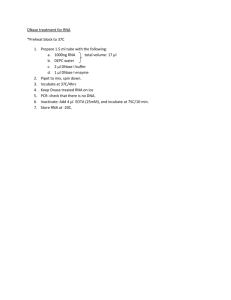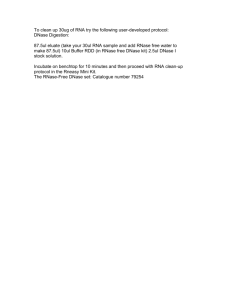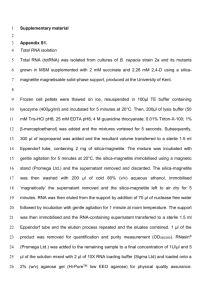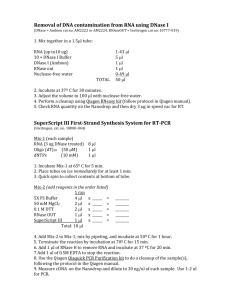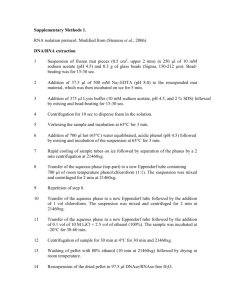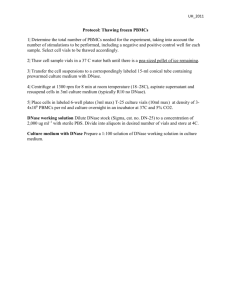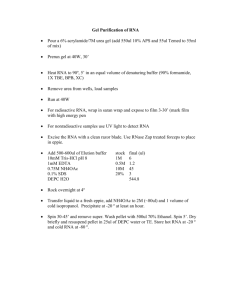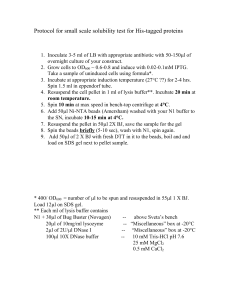Lab 5 Cleanup and Electrophoresis of C. elegans RNA
advertisement
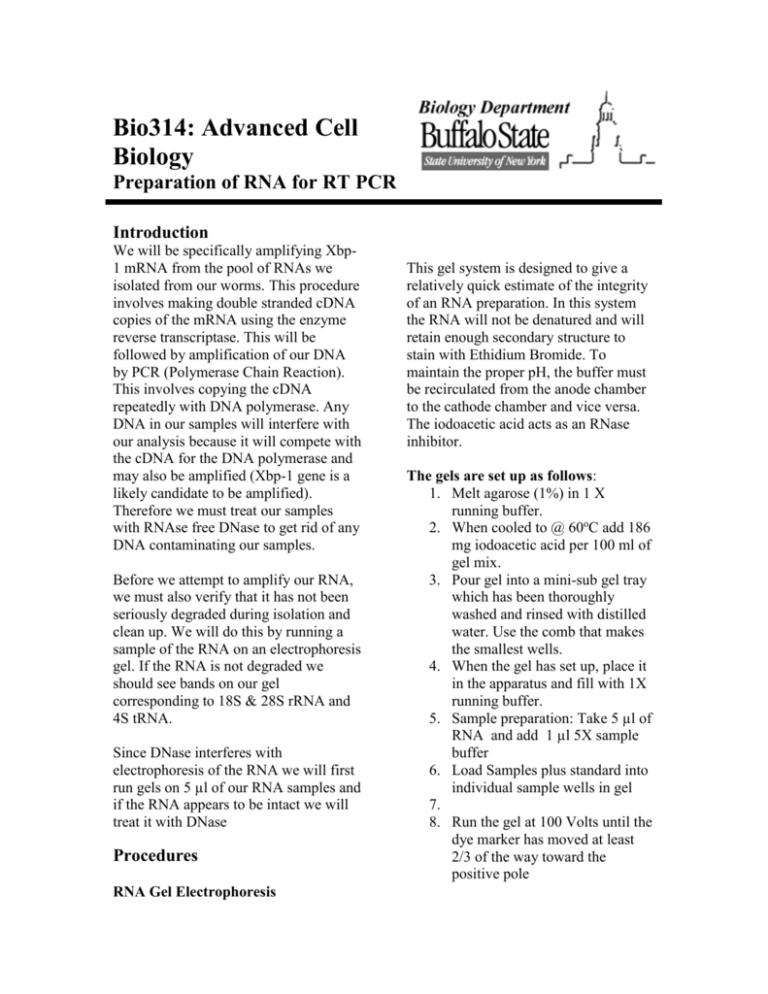
Bio314: Advanced Cell Biology Preparation of RNA for RT PCR Introduction We will be specifically amplifying Xbp1 mRNA from the pool of RNAs we isolated from our worms. This procedure involves making double stranded cDNA copies of the mRNA using the enzyme reverse transcriptase. This will be followed by amplification of our DNA by PCR (Polymerase Chain Reaction). This involves copying the cDNA repeatedly with DNA polymerase. Any DNA in our samples will interfere with our analysis because it will compete with the cDNA for the DNA polymerase and may also be amplified (Xbp-1 gene is a likely candidate to be amplified). Therefore we must treat our samples with RNAse free DNase to get rid of any DNA contaminating our samples. Before we attempt to amplify our RNA, we must also verify that it has not been seriously degraded during isolation and clean up. We will do this by running a sample of the RNA on an electrophoresis gel. If the RNA is not degraded we should see bands on our gel corresponding to 18S & 28S rRNA and 4S tRNA. Since DNase interferes with electrophoresis of the RNA we will first run gels on 5 µl of our RNA samples and if the RNA appears to be intact we will treat it with DNase Procedures RNA Gel Electrophoresis This gel system is designed to give a relatively quick estimate of the integrity of an RNA preparation. In this system the RNA will not be denatured and will retain enough secondary structure to stain with Ethidium Bromide. To maintain the proper pH, the buffer must be recirculated from the anode chamber to the cathode chamber and vice versa. The iodoacetic acid acts as an RNase inhibitor. The gels are set up as follows: 1. Melt agarose (1%) in 1 X running buffer. 2. When cooled to @ 60oC add 186 mg iodoacetic acid per 100 ml of gel mix. 3. Pour gel into a mini-sub gel tray which has been thoroughly washed and rinsed with distilled water. Use the comb that makes the smallest wells. 4. When the gel has set up, place it in the apparatus and fill with 1X running buffer. 5. Sample preparation: Take 5 µl of RNA and add 1 µl 5X sample buffer 6. Load Samples plus standard into individual sample wells in gel 7. 8. Run the gel at 100 Volts until the dye marker has moved at least 2/3 of the way toward the positive pole DNase Treatment: The following procedure is from the Promega instructions for treating total RNA with RNAse free DNase prior to RT-PCR: DNase Treatment of RNA Samples Prior to RT-PCR 1. Set up the DNase digestion reaction as follows: RNA in water or TE buffer 1–8µl Bring volume to 8µl with nuclease free water Add RQ1 RNAse-Free DNase 10X Reaction Buffer 1µl Add RQ1 RNase-Free DNase (see Note 1) 1ul 2. Incubate at 37°C for 30 minutes. 3. Add 1ul RQ1 DNase stop solution 4. Incubate at 65°C for 10 min. to inactivate DNase Freeze samples @ -70°C for use in RT-PCR Notes: 1. Use 1 unit of RQ1 RNase-Free DNase per microgram of RNA. For smaller amounts of RNA, use 1 unit of RQ1 RNaseFree DNase per reaction. 2. The RQ1 RNase-Free DNase digestion contains a final concentration of 10mM MgSO4. When adding the DNase-treated RNA to an RT-PCR reaction, carryover of magnesium must be considered. For example, the addition of 1µl of treated RNA to a 50µl RT-PCR reaction will raise the magnesium concentration by 0.2mM, and the addition of 5µl of treated RNA will raise the magnesium concentration by 1mM. The requirement for magnesium may be different in the RQ1 DNase digestion step and in the amplification reaction. RQ1 DNase activity increases as the Mg2+ concentration increases up to 5–10mM. At a concentration of 1mM Mg2+, RQ1 DNase is expected to be at least fourfold less active than at the optimal Mg2+ concentration. For some templates, the yield from the amplification reaction is highly dependent on the Mg2+ concentration, and the optimal Mg2+ concentration may be as low as 1mM. Promega Corporation · 2800 Woods Hollow Road · Madison, WI 53711-5399 USA · Toll Free in USA 800-356-9526 · Telephone 608-274-4330 · Fax 608-277-2601 · www.promega.com Reagents and Equipment: Electrophoresis 10X RNA running gel buffer: 0.4 M Tris-Base 50 mM Sodium Acetate 10 mM EDTA Adjust pH to 7.8 with glacial acetic acid 5X sample buffer 5X running gel buffer containing 50% glycerol and Bromo-phenol blue dye. Mini –sub gel apparatus with small well comb. Peristaltic pump (optional) DNase Treatment Pomega RQ1 RNase-free DNase with 10X reaction buffer and stop buffer
